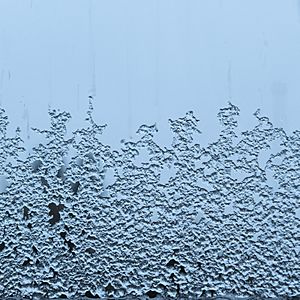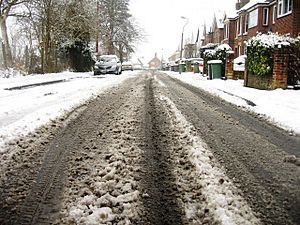Slush facts for kids
Slush is a mix of small ice crystals and liquid water. Think of it like a soupy mix of snow and water. It's also called slush ice.
Slush often forms in nature when snow or ice starts to melt. It can also appear during weather when both rain and snow fall at the same time. This mix often picks up dirt and other things from the ground. This is why slush often looks gray or muddy brown. Sometimes, solid ice or snow can block the water from draining away. This means slush can freeze and melt many times before it finally disappears.
When people use road salt to clear roads, slush can form even when it's colder than usual. This is because salt lowers the freezing point of water. So, you might see slush in salted areas, while nearby unsalted areas still have frozen snow or ice.
Contents
What are the Dangers of Slush?
Slush can be tricky because it acts like a special kind of liquid called a non-Newtonian fluid. This means it can seem solid at one moment and then suddenly turn very watery. Because of this, it's hard to guess how slush will behave.
Slush and Avalanches
This unpredictable behavior is why slush can cause avalanches. A slush avalanche can be very dangerous because it's hard to know when the slush will suddenly start to flow. This makes it a hidden natural danger.
Slush and Travel Safety
Slush can also be a big problem for airplanes on a runway. If there's too much slush, it can slow down the plane's wheels during takeoff. This can make it hard for the plane to get enough speed and can cause accidents. For example, the Munich air disaster was partly caused by slush on the runway.
On roads, slush makes surfaces slippery. It also makes it harder for cars and trucks to stop, increasing their braking distance. This can lead to more car crashes, like rear-end collisions.
Freezing Slush
After slush forms, it can refreeze. When it refreezes, it turns into solid ice. This ice can be very dangerous for both cars and people walking. It makes roads and sidewalks very slippery.
Can Slush Be Helpful?
Sometimes, slush can actually be useful! When new snow falls onto slush, it can partially melt and turn into more slush. This can help prevent roads from getting too packed with deep snow or sleet.



